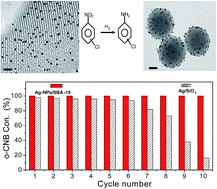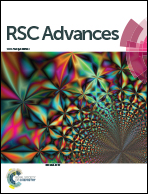Highly efficient and selective hydrogenation of chloronitrobenzenes to chloroanilines by H2 over confined silver nanoparticles†
Abstract
Ag NPs with sizes ranging form 5–6 nm confined into mesoporous silica SBA-15 (Ag-NPs/SBA-15) are successfully prepared by a facile and rapid glucose/glycol assisted one-step vacuum impregnation method. The as-prepared Ag-NPs/SBA-15 catalyst shows very good activity and selectivity for hydrogenation of chloronitrobenzenes to the corresponding chloroanilines by H2 compared with that of the SiO2 supported Ag catalysts. The robust catalytic performance of the as-prepared Ag-NPs/SBA-15 catalyst displays its potential application for the production of chloroanilines in the fine chemicals industry.


 Please wait while we load your content...
Please wait while we load your content...